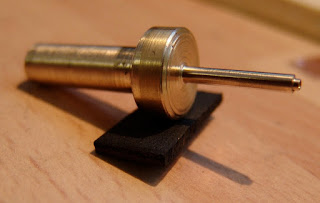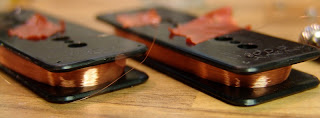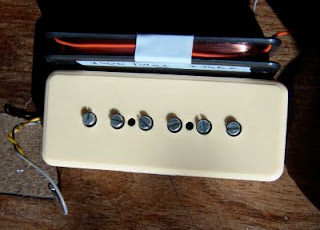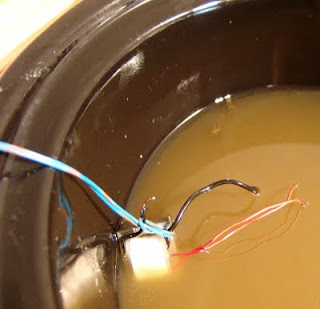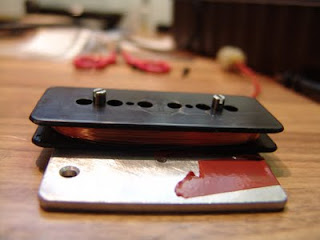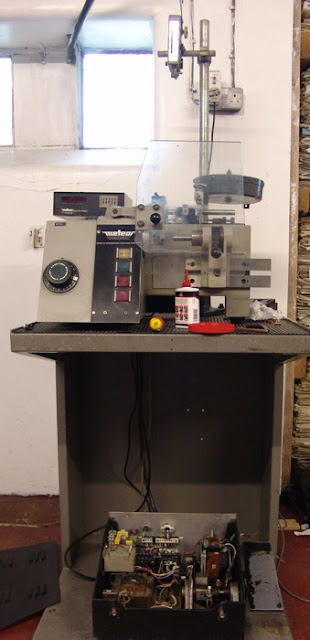🙂
Tag: Coil winding
Hexapup hexaphonic pickups now available.
One of the great things about being a micro-business is that you can act quickly! There is no management structure, no liaising with a marketing or accounts departments – we don’t have them! And best of all, no office politics! This means that if we have a good idea, or even a stupid one, we can do it straight away.
|
Hexapup in a Gretsch-style ‘toaster’ cover
|
Last month we made a stereo guitar pickup prototype, and it was fairly clear from our customers and comments on forums that a few people might want one. So now, six weeks later, we have a ‘production’ version in a humbucker sized* can – the Hexapup!
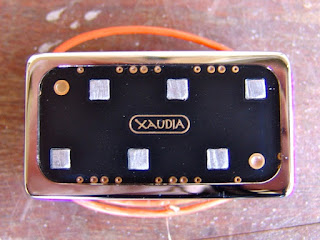 |
| Hexapup – hexaphonic guitar pickup |
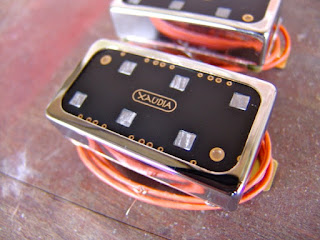 |
| Hexapup guitar pickup |
The hexapup is actually made of six small pickups, and can be wired for mono, stereo or hexaphonic output
Mono
When wired as a conventional mono pickup, the hexapup has a bright single coil tone. But it also has hum rejection (humbucking) properties because the coils on one side are reverse wound, with reverse magnet polarity.
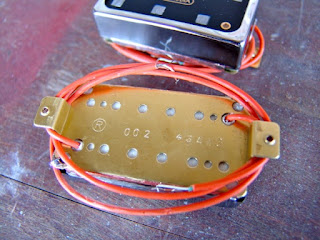 |
| Hexapup – serial number 002 with 43AWG wire |
Stereo
There are two obvious ways for stereo wiring. Either bottom-and-top, or alternating strings. Put another way, the lowest three strings can be sent to one output, and the highest to the other, so power chords could have one sound, and solos another. Or, the E, D and B strings sent to the left, and A, G & e to the right. This makes for nice stereo width, and is great for multi-tracking chords, and chorus type effects. I have my guitar wired this way!
 |
| Hexapup being mounted to a customer’s guitar |
Hexaphonic
Each coil can be given its own output, volume and tone control which, with series / parallel and phase options gives a staggering number of combinations. Each string can be sent to a different distortion or delay to get strange new sounds, and could even be auto-tuned or pitch shifted separately – that might be weird. With six outputs, imagination is the only limit!
I’ll be writing a bit more about the technical specs in a couple of days, so stay tuned.
* Actually a little deeper than a normal humbucker, but most guitars have plenty of space.
Stereo hexaphonic pickup prototype
I have been thinking for some time about a stereo guitar that would spread out the signals from the different strings to a pair of amplifiers, or to stereo inputs for recording. So here is my first attempt at winding a stereo pickup.
In order to get some separation between the strings, I decided to make six mini-pickups and combine them into sets of three. Here are the parts – six bobbins, six steel pole pieces, an Alnico 5 bar magnet, and a home made top board.
Each was a coil of 5000 turns 42 AWG enamel wire, around a steel bar. Three of the coils were wound normally and three reverse-wound as they will sit on magnets of reverse polarity.
 |
| Winding mini-pickups on the Meteor winder |
These were then arranged in two sets of three, magnetised by a bare of Alnico 5. The hard part is keeping track of the winding direction, the start and end of the wires, and the magnet polarity – so that everything is in phase! Each set of three coils were wired in series, and the E,D & B strings sent to one output, and A,G & E sent to the other. Once done, the parts were glued in place, soldered, and then dipped in the wax bath.
 |
| Assembled six-coil pickup with magnet |
And then it was mounted in the test guitar – my trusty Reverend Slingshot, with the pickup simply taped in place for a test run. The next job is to mount it properly and put a cover on to hide the mess – the hard bit was finding an undrilled P90 cover, but ebay came to the rescue.
 |
| Reverend Slingshot with prototype stereo pickup |
So, how does it sound? Here is a little run on the guitar and the screenshot from protools. The recording was made into the instrument input of an API A2D, using the digital output at 24bit, 96 kHz into protools. Then no further processing, other than bouncing to 44.1 kHz, 16 bit.
[The stereo image of laptop speakers is usually pretty awful, so best checked out on headphones!]
As always, the stereo is much better on the .Wav version (5 mb…)
The isolation between the two sets of strings is actually very good – you can hear and see on the screen shot that the two channels are very different, following the two sets of strings. It gives a nice interesting stereo spread with the run on the B-string being panned to the right, and the lower notes played on the A string going left.
Another stereo example is here, along with the separate left and right components.
I imagine this would be good for double tracked guitars with big Pete Townsend style chords – using two amps. Although this is wired for stereo, it could easily be made into a hexaphonic* pickup. I’m not sure what use that would be in the real world, but it would certainly be fun to find out.
Update: Here is the pickup mounted properly in the Reverend guitar
Footnote
*The concept of a hexaphonic pickup is by no means new. The earliest patent reference that I could find to the word ‘hexaphonic’ is in this application by Gibson filed in 1990. This refers to midi pickups and states “The first category usually makes use of a special pickup which is mounted on a normal guitar as is the case in the present invention It is deemed important to retain the guitarness or feel of the instrument and a retrofittable hexaphonic magnetic pickup is utilized….” So the idea of hexaphonic pickups was well understood by that point, and in fact must have been obvious even to the very first pickup winders.
Digging deeper I found this article on polyphonic pickups, in Premier Guitar magazine, which covers the subject in better detail than I ever could.
And here is a story from the Gretsch website about Chet Atkin’s stereo guitar from 1956, which used a split coil to send the three bass strings to one side, and the three treble strings to the other. They applied for patent in 1956, and this was granted in 1960.
Marvin the Meteor
We have just installed a second Meteor ME307 coil winder at Xaudia, for rewinding ribbon mic transformers, pickups and making new parts.
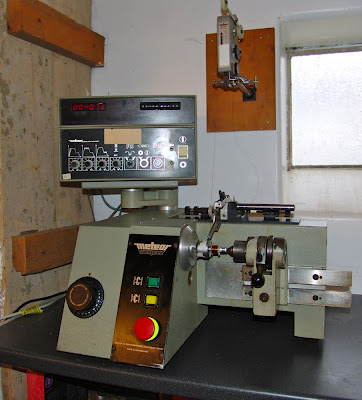 |
| Meteor ME307 with electronic controller |
 |
| Marvin the paranoid android from the original TV series of Hitchhiker’s Guide to the Galaxy |
 |
| Marvin the Meteor coil winder |
Marvin even has a brain, although perhaps not the size of a planet. It has more sophisticated controller than our existing Meteor winder, which just has manual controls and a foot pedal. The newer model has preset adjustable ramp, speed, idle, and also a reverse wind setting, which is very handy and removes much of the human element from the winding. Let’s hope he isn’t bad tempered like his namesake !
‘Yorkshire Tour’ Stratocaster pickups
I spent Saturday helping my former band-mate Ant make new pickups for his 1983 Fender Stratocaster – the stock pickups were OK but lacked a little warmth, and he wanted something overwound (i.e. more turns than a ‘standard’ strat pickup), to give a hotter, fatter sound inspired by Rory Gallagher’s ‘Irish Tour’ album.
 |
| Ant makes single coil pickup formers from board and magnets. |
Magnetic fields fall away rapidly with distance, and with a moulded plastic bobbin, there is inevitably a gap between the pole piece and the coil. Instead, we made the pickups in the traditional manner, with board and Alnico-V magnets supplied by the mighty StewMac.com. Although it takes a little time to construct the pickup in this manner, this method does give a better sound, as the copper wire coil is wound directly onto the magnets, with the most intimate contact possible.
| The old strat pickup assembly removed |
We made a couple of small tools to help with the assembly. A pair of acrylic blocks were cut to act as spacers between the top and bottom of the pickup, to keep the boards parallel. One of these was drilled to help align the magnets as they were knocked into place. The other tool was a spindle for the coil winder.
 |
| Knocking in the magnets – a strip of wood protects the magnet from the hammer! |
Once the three bobbins are assembled and glued, it is a simple case of winding the required number of turns onto the former without breaking the wire! The neck and mid pickups were wound with 9000 turns of 42 AWG plain enamel copper wire, and the bridge pickup with 9800 turns, which gave DC resistances of 6.7 kΩ and 7.4 kΩ respectively. 7.4kΩ indicates that around 1300 meters of wire has been wound onto the pickup! For comparison, according to Vintage Guitars Info, the original Stratocaster pickups measured circa 5.8 kΩ to 6.3 kΩ.
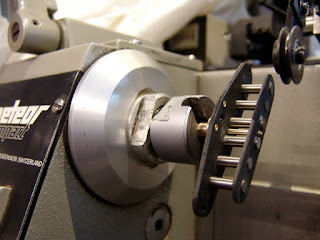 |
| An assembled pickup – magnets and flatwork – on the coil winder. |
It was interesting to see how the original pickups were wound – they are pretty inconsistent, and one in particular had substantial asymmetry to the coil. Perhaps there is some magic to this, but we suspect that it was just their winder drifting out of alignment and piling up the wire on one side.
| Fender Stratocaster pickup, circa 1983. |
Our pickups were a bit neater than that! Once wound, the lead wires are soldered on, and the complete pickups are dipped in the wax bath to stop microphonics, and then magnetised. A pair of very powerful 1 inch circular neodynium magnets were used to magnetise the Alnico 5 pole pieces, and we measured around 900 to 1100 gauss for each of the poles. The middle pickup was reverse wound, and given a reverse polarity, by simply flipping the bobbin over for the winding and magnetisation processes. This gives some humbucking when the mid-positions are selected.
The verdict? “Those pickups are PHAT!! Awesome. Loads more bass!“
 |
| Back together again – Stratocaster heaven! |
Making a spindle for winding pickups
Next week we will be making a few single coil pickups for Stratocasters, so I quickly made this simple little spindle tool to help with the job. It was machined this from 15 mm brass stock on the new mini-lathe, which arrived earlier this week. Below is the roughly machined spindle, before cleaning.
The pickup bobbin slips onto the 3mm post, supported by the wide shoulder, and is locked in place by a square of flatwork board, screwed into the side. This prevents the pickup from slipping on the spindle, without interfering with the wire as it is wound on. The barrel was turned down to 8 mm to fit the Meteor coil winder, although it could equally well be used on a power drill chuck.
Fender Telemaster build
My holiday project was assembling this Telemaster guitar, from parts acquired that I have accumulated over the past six months or so.
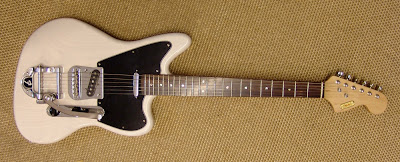 |
| Fender (ish) Telemaster guitar, Xaudia |
The ‘Telemaster’ is an imagined product that Fender might have made in the 1960s or 70s, but never did – it is essentially a Jazzmaster body with Telecaster hardware. In this case I used a neck with a Strat-style headstock, and added a Fender-badged Bigsby vibrato, simply because I love the Bigsby sound.
The ash body & scratch plate were made and sprayed by John Manuel of Carlisle, who did an amazing job with a nitrocellulose transparent white – it really shows the lovely grain below. He can be contacted through ebay.
The neck and locking tuners were from Vanson guitars. The neck is pretty nice quality, although I did need to rub it down with some very fine abrasive paper to remove a couple of rough spots in the varnish. I found it slightly chunkier in profile than an original Jazzmaster neck.
 |
| Bigsby with super-tremola upgrade |
One thing that I don’t love about Bigsbys is re-stringing them. The ball ends of the strings have a tendency to slip off the metal posts, which can be very frustrating, and one really needs four hands for the job – to hold the string at both ends, keep in under tension, and turn the tuner! Two things help with this – firstly locking tuners clamp the string at that end, and also I have fitted a Duesenberg super tremola kit, from Rockinger, which replaces the posts with a through-hole system. Much less frustrating!
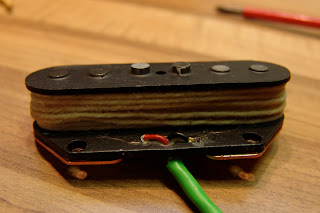 |
| home made telecaster pickup |
The pickups are of course home made, and I tried to get as close to the original Telecaster specs as I could. Rather than using a bobbin/former to wind the coil, the core of the pickups were made using top and bottom ‘flatwork’, glued to Alnico rods. Enamelled wire was then wound directly onto the magnets, which avoids the gap between magnets and wire that is inherent with a plastic former.
The bridge pickup was wound with 8500 turns of 42 gauge wire, and the bridge was reverse-wound with around 6500 turns of 43 gauge, and of course reverse polarity for the magnets. Once wound, the pickups are wrapped with string to protect the delicate coil, and then dipped in wax to stop microphonics. The whole thing is very solid, and rather heavy.
I did briefly consider adding a headstock decal to complete the fake Fender look, but decided that it was too good to give anyone else the credit – so it has a nice Xaudia badge. I am rather proud of it! 🙂
The shape of things to come….
Reslo transformers vs the WEE monster
This little dinosaur sculpture was made out of waste winding coils, stripped mostly from old Reslo and other microphone transformers. 🙂
So why are we stripping transformer coils?
Some older ribbon mics were originally wound for 30 or 50 ohm output impedance, and tend to give a low output level when connected to modern recording equipment.
Many of these low impedance mics, including Reslo and Tannoy ribbons, can be rewound for a modern 200 or 600 ohm input, raising the output to a more useable level, and avoiding noise from having to crank up the preamps.
 |
| Bobbin from Reslo transformer with secondary winding removed. |
The old Relso 30/50 ohm transformers have an inner (primary) winding consisting of just 12 or 13 turns of thick (0.8 mm) enamelled wire, and a secondary winding of 152 turns of 0.4 mm wire. The thick wire of the inner winding ensures that the primary resistance is low, which keeps noise to a minimum.
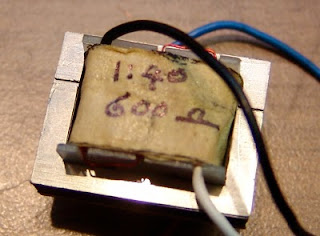 |
| Reslo transformer rewound for 600 ohm output |
Re-winding the transformer involves removing the outer winding from the original transformer and replacing it with sufficient turns of a thinner gauge to reach the desired turns ratio and output impedance. Usually the original primary winding can be kept in place. The transformer is then reassembled and dipped in wax to fix the windings and lams in place.
This makes the microphone much more usable in a modern studio – transformers can be would for 250Ω, 600Ω or any other desired output impedance.
Coil winder 3 – guitar pickups
There is no ‘Mic of the Month’ article this month – normal service will resume in July. You can read the archive HERE.
Since the Meteor ME307 coil winder arrived, things have been rather hectic and we’ve been busy getting it working, and having some fun winding transformers, inductors and pickups. The friction wheel / clutch that drives the lateral action was worn, but we were able to get a good used replacement part from Poland, and everything is working well.
Hungry? P-p-p-pickup a P90…
James from Hungry Ghosts came down to the Xaudia workshop for an afternoon, which we spent rolling our own guitar pickups. James wanted a pair of P90s to replace the stacked humbuckers on his ‘Vintage’ guitar, and I was still playing about with options for my Reverend Slingshot.
P90s are pretty simple things. We made the base plates by drilling and tapping a bar of 5mm square mild steel, and two “Alnico-5” magnets were glued to this, side by side, like this.
We wound four bobbins, at 7000, 8000, 8500 and 9500 turns, reverse winding some so that they could combine to give a humbucking effect….
Dipping the magnets in hot wax prevents microphonics, and we rigged up a ‘redneck’ wax potting system using a £10 slow cooker from Tesco. This works really well and I’ll describe it in a separate blog post. That done the pickups could be assembled and wired.
I found some nice deep headed screws which made perfect pole pieces for the pickups. Here is the finished P90…
And the new pickups imbued James’ guitar with a spooky pink glow!
Redneck wax potting bath
We needed a better way of wax potting our pickups and transformers. Here’s what we did on a budget…
 |
| Redneck wax potting bath for guitar pickups |
It’s a hacked 300 Watt slow cooker, acquired from Tesco for the grand sum of £10, which contains an inner ceramic liner and holds about 3 litres. The probe is simply a cook’s thermometer (£14 from Barnitts of York).
It takes a little while to warm up, but sits at about 90 degrees all day, which is just about perfect for potting. The temperature can be further tweaked by running the bath on a variac.
Here’s a newly dipped transformer coming out of the soup – a mix of bees wax and parafin wax…
Coil winding part 2
The new ME307 coil winder is up and running, and we’re jumping straight in to winding some guitar pickups. The idea was that this should be an easy place to start as they can be made with a single winding, and bobbins, wire etc. are all readily available. There is a big pickup winding community in interweb-land, so help and advice should be available.
The winder in action, with the pickup mounted on a metal plate that we made for the job…
Pickups typically use circa 42 AWG wire (0.0633 mm), which is a very fine gauge and requires care whilst winding and soldering to avoid breakages.
The wire tensioners that came with the winder were a little out of calibration, but with a little practice at setting the correct tension and winding speed, we could easily get 7000 turns onto a P90 bobbin with room to spare. It’s probably possible to get 8000 or 9000 turns with practice, to wind a really hot pickup. Here’s the first winding from the Meteor….
Looks nice! The next step will be to rewind some of the broken microphone transformers that we have accumulated over the past few years. But before that we need to mend the clutch plate, which is slipping.
Our New Coil Winder – Meteor ME307
The ‘new’* Meteor ME307 coil winder has just arrived at the Xaudia workshop, after a 500 mile round trip to collect it…
We are very excited about this as it will expand our repair abilities and let us rebuild and rewind broken microphone transformers and guitar pickups. It has a counter to set the number of turns, foot actuated motor control, and of course the all important set of tensioners to allow the wire to be spooled at the correct tension.
The coil winder was probably built sometime in the 80’s and is built like a tank, with some beautiful Swiss engineering inside. Everything needed a little lubrication and a good clean and, although the machine has clearly seen some years of use, everything is still working perfectly.
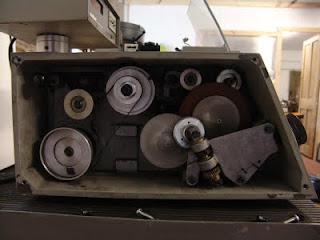 |
| ME307 internal gears and drive train. |
We hope to be doing our first windings later this week…







